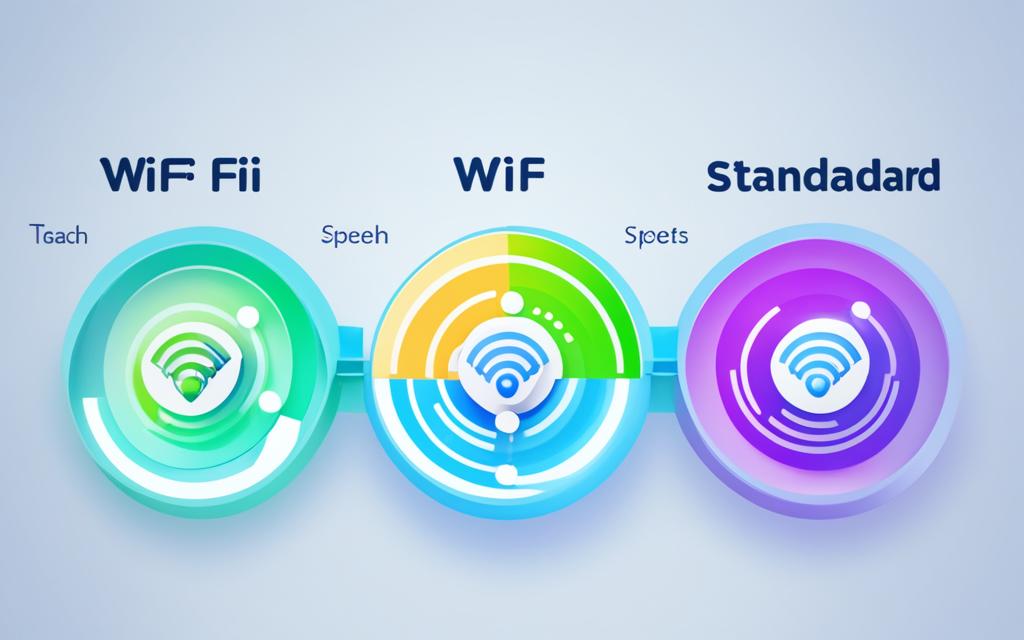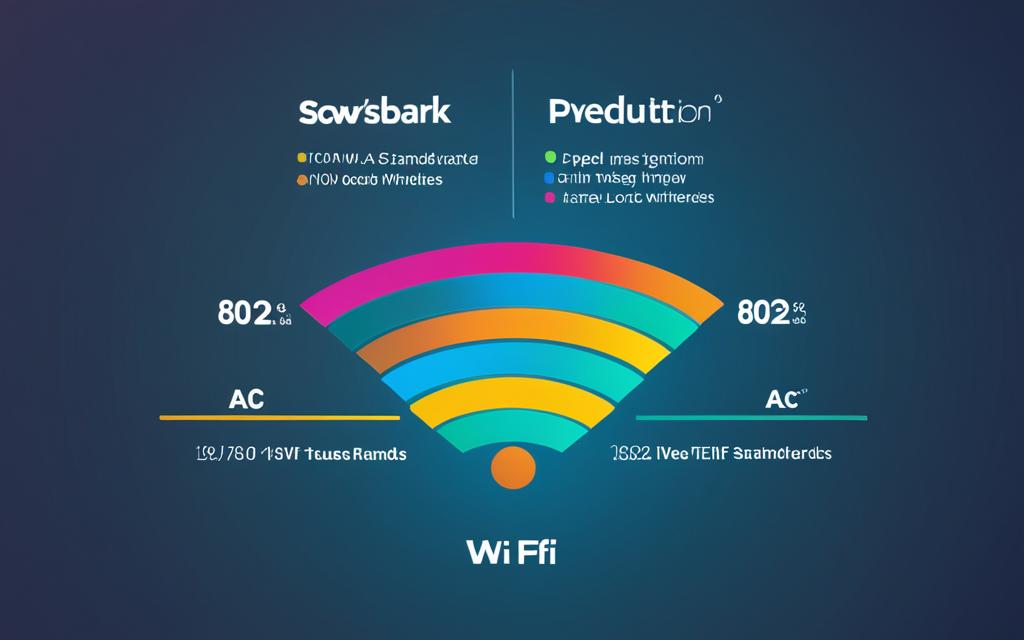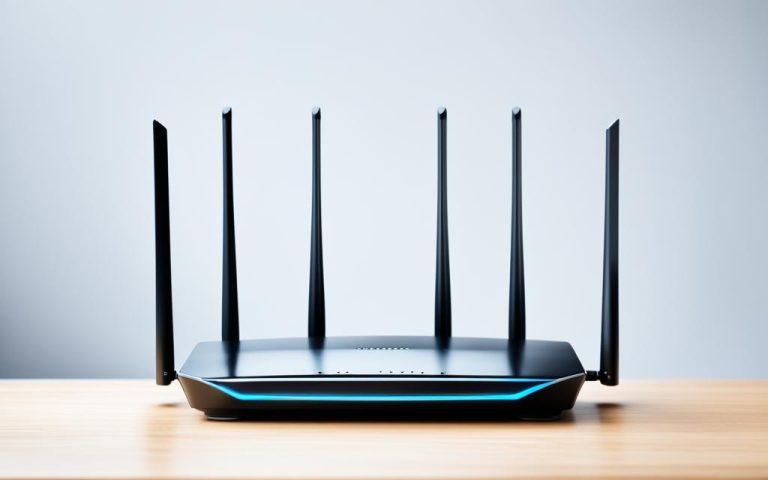Wi-Fi technology has become an integral part of our daily lives, enabling seamless connectivity and wireless communication. As technology evolves, so do the standards that govern Wi-Fi networks. It is essential to understand the impact of these Wi-Fi standards on local area wireless networks.
From Wi-Fi 5 (802.11ac) to Wi-Fi 6 (802.11ax), each new standard has brought significant advancements in speed, performance, and functionality. These standards have revolutionized the way we connect and interact with the digital world.
Now, the focus is shifting towards the adoption of Wi-Fi 7 (802.11be) and other emerging standards. These standards promise to take local area wireless networks to new heights, offering faster speeds, improved range, and enhanced capabilities.
As the industry continues to innovate, staying up-to-date with the latest Wi-Fi standards is crucial for businesses and individuals alike. Understanding how Wi-Fi standards impact local area wireless networks can help optimize network performance, improve connectivity, and unlock new possibilities.
In this article, we will explore the evolution of Wi-Fi standards, delve into their key features and benefits, analyze their adoption and market trends, and take a glimpse into the future of Wi-Fi standards.
Join us on this journey through the world of Wi-Fi standards and discover how these technological advancements shape the connectivity landscape.
The Evolution of Wi-Fi Standards
Wi-Fi standards have undergone significant advancements since the release of the original 802.11 standard in 1997. Over the years, several improved standards have been introduced, each bringing faster speeds and enhanced performance to wireless networks.
The journey began with Wi-Fi 5 (802.11ac) and Wi-Fi 6 (802.11ax), which revolutionized the industry by delivering higher speeds and improved connectivity. These standards offered faster data transfer rates and increased network capacity, providing users with a smoother and more efficient online experience.
Now, the focus has shifted to the latest standard, Wi-Fi 6E. Utilizing the 6GHz frequency band, Wi-Fi 6E takes wireless connectivity to the next level, offering even higher speeds and an extended range. This additional spectrum enables Wi-Fi 6E devices to operate in less crowded, interference-free environments, ensuring a seamless and uninterrupted connection for users.
Looking ahead, the industry is eagerly anticipating the arrival of Wi-Fi 7, the next major advancement in wireless technology. Wi-Fi 7 is expected to provide a maximum theoretical speed of 46Gbps, marking a significant leap in performance. With its ultra-fast speeds, Wi-Fi 7 will empower various applications such as multi-user augmented reality/virtual reality (AR/VR), hybrid work environments, and industrial Internet of Things (IoT) solutions.
As the evolution of Wi-Fi standards continues, users can expect faster speeds, improved efficiency, and a richer digital experience. These advancements will drive innovation across industries and open up new possibilities for wireless connectivity.
Key Features and Benefits of Wi-Fi Standards
Each Wi-Fi standard brings its own set of key features and benefits. These features enhance the performance and capabilities of local area wireless networks, providing users with faster speeds, improved coverage, and better connectivity.
Wi-Fi 5 (802.11ac)
Introduced multiple input multiple output (MIMO) technology, allowing for faster data transmission and better coverage. This increased the efficiency of wireless connections, providing a more reliable and stable network experience.
Wi-Fi 6 (802.11ax)
Introduced a multi-user mechanism that enables higher throughput and better performance in data-heavy situations. This feature allows multiple devices to share the network simultaneously, eliminating congestion and reducing latency.
Wi-Fi 6E
Takes advantage of the 6GHz frequency band to offer higher real-world speeds and improved range. By utilizing this additional spectrum, Wi-Fi 6E provides a less congested environment for devices, resulting in faster and more reliable connections.
Wi-Fi 7 (802.11be)
With its ultra-wide channels and multi-link operation, Wi-Fi 7 promises even faster speeds and is specifically designed to meet the demands of multi-user applications. It is ideal for scenarios such as multi-user augmented reality/virtual reality (AR/VR), hybrid work environments, and industrial Internet of Things (IoT) applications.
“Wi-Fi 7 offers blazing fast speeds and advanced features that cater to the ever-increasing demands of modern wireless networks.”
By continuously improving and introducing new features, Wi-Fi standards propel the evolution of wireless technology, enabling faster, more reliable, and efficient data transmission. These advancements empower businesses and individuals with seamless connectivity and support the growing needs of the digital era.

Stay tuned for the next section where we will explore the adoption and market trends of Wi-Fi standards, shedding light on their widespread usage and future implications.
Adoption and Market Trends of Wi-Fi Standards
The adoption of Wi-Fi standards is experiencing rapid growth, as businesses and industries recognize the benefits and advancements these standards bring to their wireless networks. Wi-Fi 7, the upcoming standard, is anticipated to witness wide-scale adoption across various sectors, revolutionizing connectivity and performance.
According to IDC’s worldwide Wi-Fi technology forecast, the market is set to witness a surge in the number of Wi-Fi 7 devices, with over 233 million anticipated to enter the market by 2024. This trend is projected to continue, with the number of devices expected to reach a staggering 2.1 billion by 2028.
In terms of early adopters, smartphones, PCs, tablets, and access points (APs) take the lead in embracing the advancements of Wi-Fi 7. These devices are at the forefront of driving adoption, leveraging the improved speeds and capabilities offered by the new standard.
“Wi-Fi 7 is set to revolutionize the way we connect and communicate wirelessly. Its exceptional performance and reliability make it a game-changer for various industries.”
In addition to the aforementioned devices, other sectors such as customer premises equipment (CPE) and augmented and virtual reality (AR/VR) equipment are also expected to witness considerable growth in the adoption of Wi-Fi 7. These emerging markets recognize the transformative potential of Wi-Fi 7 in enhancing their operations and delivering a seamless user experience.
To visualize the market trends and adoption rate of Wi-Fi standards, the following table presents the anticipated growth and market share of Wi-Fi 7 devices:
| Year | Number of Wi-Fi 7 Devices (in millions) | Market Share |
|---|---|---|
| 2022 | 15 | 6% |
| 2024 | 233 | 28% |
| 2026 | 700 | 45% |
| 2028 | 2,100 | 80% |
Note: The market share represents the percentage of Wi-Fi 7 devices in relation to the total number of Wi-Fi devices in the corresponding year.
The Future of Wi-Fi Standards
The future of Wi-Fi standards looks bright, as ongoing developments and advancements continue to shape the landscape of local area wireless networks. The Institute of Electrical and Electronics Engineers (IEEE) is at the forefront of pioneering new technologies that will revolutionize Wi-Fi connectivity.
Exploring New Technology Areas
The IEEE is actively exploring new technology areas to enhance Wi-Fi standards. One key area of focus is enhanced data privacy, which aims to safeguard sensitive information transmitted over Wi-Fi networks. WLAN sensing is another area of interest, enabling Wi-Fi devices to detect and analyze their surrounding environments, leading to improved network optimization and performance.
Additionally, the IEEE is investigating randomized and changing MAC addresses, addressing concerns about device identification and enhancing privacy protection.
Innovating with Ambient Energy and AI/ML Applications
Special-interest groups within the IEEE are exploring innovative approaches to power Internet of Things (IoT) devices using ambient energy sources. This exciting endeavor aims to reduce reliance on traditional power sources and enable IoT devices to operate efficiently with minimal environmental impact.
Furthermore, the IEEE is actively working on developing new algorithms that support artificial intelligence/machine learning (AI/ML) applications. These algorithms will optimize network performance and enable seamless integration of AI/ML technologies into Wi-Fi networks, unlocking new possibilities for automation and intelligent data analysis.
Interoperability and Extended-Range Wi-Fi Networks
Interoperability between Wi-Fi and LiFi systems is a major focus for the IEEE and the Global Light Communication Standard. This collaboration aims to seamlessly integrate LiFi technology, which uses light waves for wireless communication, with Wi-Fi networks. The future holds the potential for even faster and more secure wireless connections, as the boundaries between Wi-Fi and LiFi continue to blur.
Another exciting development is the 802.11ah standard, which aims to create extended-range Wi-Fi networks. This standard will enable Wi-Fi signals to travel farther and penetrate through walls and obstacles, providing better coverage and connectivity in larger areas.
Wi-Fi Standards in Development
| Wi-Fi Standard | Key Focus Areas |
|---|---|
| Enhanced Data Privacy | Safeguarding sensitive information transmitted over Wi-Fi networks |
| WLAN Sensing | Detecting and analyzing the surrounding environment for improved network optimization |
| Randomized and Changing MAC Addresses | Enhancing privacy protection and device identification |
| Ambient Energy for IoT | Exploring new power sources to support IoT devices |
| AI/ML Algorithms | Optimizing network performance and enabling integration of AI/ML applications |
| Interoperability with LiFi | Seamless integration of LiFi systems with Wi-Fi networks |
| Extended-Range Wi-Fi Networks | Enhancing Wi-Fi coverage and connectivity in larger areas |
Conclusion
Wi-Fi standards are integral to the performance and connectivity of local area wireless networks. Each standard, from Wi-Fi 5 to the upcoming Wi-Fi 7, brings its own unique features and benefits. The rapid adoption of these standards, especially Wi-Fi 7, is expected across various industries, promising widespread enhancement in wireless technology.
The future of Wi-Fi standards looks promising, with ongoing developments in critical areas such as enhanced data privacy, WLAN sensing, and the utilization of ambient energy. As technology continues to evolve, it is crucial to stay informed and understand the impact of Wi-Fi standards in order to optimize local area networking and stay ahead of the evolving demands of the digital age.
By embracing the advancements in Wi-Fi standards, organizations can unlock greater speeds, improved range, and enhanced performance, enabling them to meet the growing connectivity needs of users and creating opportunities for innovation across industries. As the world becomes increasingly interconnected, staying updated with Wi-Fi standards will remain essential for businesses and individuals alike.
FAQ
What is Wi-Fi 7 (802.11be) and how does it impact wireless networks?
Wi-Fi 7 is the next major advancement in wireless technology, with a maximum theoretical speed of 46Gbps and a wide range of applications. It is expected to improve the performance and capabilities of local area wireless networks.
What are some other Wi-Fi standards being developed?
The IEEE is also working on standards such as 802.11bb for communication via light waves, 802.11az for improved location accuracy, and 802.11bd for vehicle-to-vehicle wireless communication, aiming to enhance wireless network performance and capabilities.
How have Wi-Fi standards evolved over the years?
Since the release of the original 802.11 standard in 1997, we have seen the introduction of Wi-Fi 5 (802.11ac), Wi-Fi 6 (802.11ax), and Wi-Fi 6E. Each iteration has provided faster speeds, improved performance, and expanded the capabilities of local area wireless networks.
What are the key features and benefits of Wi-Fi standards?
Wi-Fi 5 introduced multiple input multiple output (MIMO) technology for faster data transmission and better coverage. Wi-Fi 6 introduced a multi-user mechanism for higher throughput and improved performance. Wi-Fi 6E utilizes the 6GHz frequency band for higher speeds and improved range. Wi-Fi 7 promises even faster speeds and is designed for applications such as multi-user AR/VR, hybrid work, and industrial IoT.
What is the adoption and market trends of Wi-Fi standards?
According to IDC’s worldwide Wi-Fi technology forecast, more than 233 million Wi-Fi 7 devices are expected to enter the market in 2024, growing to 2.1 billion devices by 2028. Industries such as smartphones, PCs, tablets, access points (APs), customer premises equipment (CPE), and augmented and virtual reality (AR/VR) equipment are among the earliest adopters of Wi-Fi 7.
What does the future hold for Wi-Fi standards?
The future of Wi-Fi standards is promising, with ongoing developments in areas such as enhanced data privacy, WLAN sensing, the use of ambient energy, AI/ML applications, interoperability of LiFi systems with Wi-Fi, and the creation of extended-range Wi-Fi networks. These developments will continue to shape the future of local area wireless networks.



















